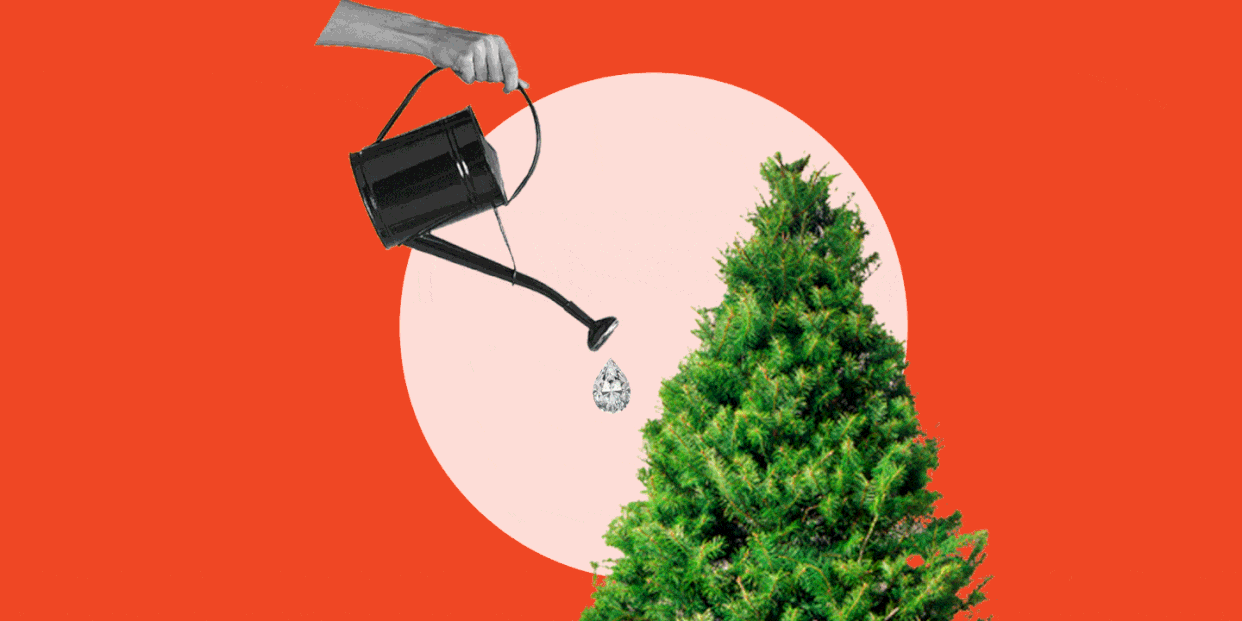If Your Christmas Tree Is Always Dead by Christmas Eve, Let’s Talk

Buying your own tree and lugging it up several flights of stairs is the definition of peak adulthood.
While there’s a lot of contradicting info on whether buying a real or fake tree is safer for the environment, consider this: If you buy local from a Christmas tree farm, the trees are grown like crops and harvested as such. “You can choose to support family farms and you’re investing in a local business, plus the tree is a product of nature and will decompose over time, unlike a plastic tree,” says Tim O’Connor, executive director of the National Christmas Tree Association (yup, that’s a thing). They also provide animal habitats and use CO2 in the air to grow.
Also, have you even SMELLED a fresh tree? Ugh, that alone makes it worth it, IMO. And if you’re spending hard-earned cash money for an evergreen of your own, you’ll need to know how to take care of her so she lasts all season. And that’s why we’ve gathered here today.
Hold out on buying one as long as you can.
When you buy your tree is important. It might be tempting to start decorating for Christmas early, but O’Connor recommends waiting until after Thanksgiving to buy a real tree. A tree lasts longer than a vase of flowers, but you still have only a limited amount of time that it will stay alive and healthy. So don’t expect to put it up at the beginning of November and have it last through New Year’s.
Be choosy about which tree you buy.
Sure, this might mean dragging bae around the lot a few more times, but make it an experience! “Look for a tree that’s green and healthy. You want the branches to be pliable, soft, and bend rather than break,” says O’Connor. Cutting your own tree at a tree farm (if you can) will also give you the freshest pick possible, adding to its lifespan by the days it would take to get to a tree lot.
Prep the tree before you put it inside.
Do not skip this step! Once you get the tree home, you need to give the trunk a fresh cut. “Use a saw to take three-quarters of an inch to one inch off the end. It helps open up the veins of the tree that get clogged with sap when the tree is initially cut,” says O’Connor. “Put it in water immediately after cutting it.” Pro tip: Setting up your tree stand before you cut the bottom makes the whole process easier.
Think about placement.
Heat and your tree don’t mix, so don’t position it over a heat register or set it up too close to a fireplace. Make sure that the lights on the tree are safe as well. You don’t want old bulbs that will burn the needles. Any heat source causes the tree to dry out.
Do not let the tree run out of water.
If you remember nothing else from this article, do not under any circumstance let the tree run out of water. “If the tree stand goes dry, the base of the trunk will sap over and then when you refill it, the tree won’t be able to absorb the water,” says O’Connor. “That first week, you’ll want to check it frequently—at least once or twice a day—because it’s going to consume a lot of water.”
The good news? If you follow these easy maintenance tips, your tree will look pretty great (and won’t shed as many needles everywhere) throughout the holiday season.
You Might Also Like

